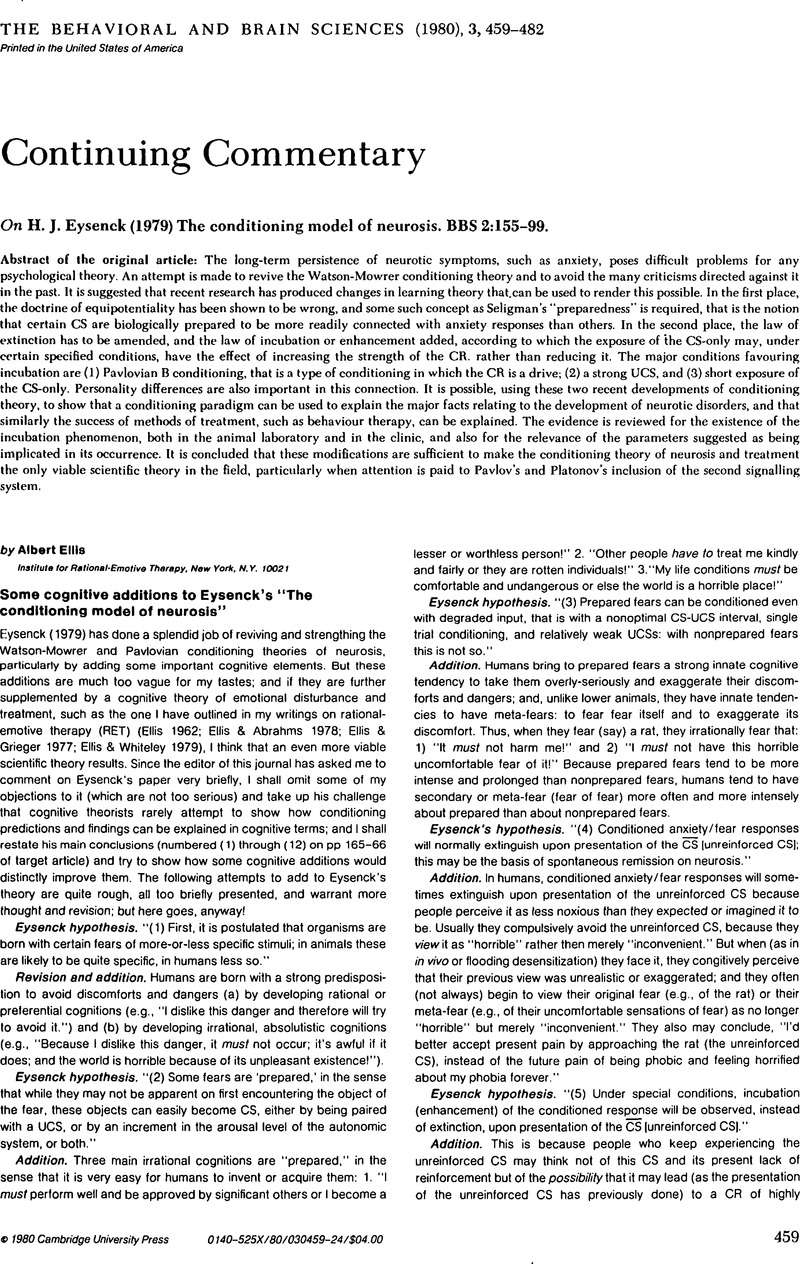No CrossRef data available.
Article contents
Some cognitive additions to Eysenck's “The conditioning model of neurosis”
Published online by Cambridge University Press: 04 February 2010
Abstract
An abstract is not available for this content so a preview has been provided. Please use the Get access link above for information on how to access this content.

- Type
- Continuing Commentary
- Information
- Copyright
- Copyright © Cambridge University Press 1980
References
REFERENCES
Agras, W. S.; Chapin, H. N.; & Oliveau, D. C. (1972) The natural history of phobias: course and prognosis. Archives of General Psychiatry 26:305–17. [DF]CrossRefGoogle ScholarPubMed
Bartemeier, L. H.; Kubie, L. S.; Menninger, K. A.; Romano, J.; & Whitehorn, J. C (1946) Combat exhaustion. Journal of Nervous and Mental Diseases 104:358–89, 489–525. [DF]CrossRefGoogle ScholarPubMed
Blanchard, E. B., & Abel, G. G. (1976) An experimental case study of the biofeedback treatment of a rape-induced psychophysiological cardiovascular disorder. Behavior Therapy 7:113–19 [DF]CrossRefGoogle Scholar
Burgess, A. W., & Holmstrom, L. L. (1974) Rape: victims of crisis. Bowie, Md.: Robert J. Brady Co. [DF]Google ScholarPubMed
Dörner, G. (1972) Sexualhormonabhilngige Gehimdifferenzierung und Sexuälitat. Vienna: Springer-Verlag. [VP]CrossRefGoogle Scholar
Douglas, R. J. (1972) Pavlovian conditioning and the brain. In: Inhibition and learning, eds. Boakes, R. A. & Halliday, M. S.. London: Academic Press. [RKP]Google Scholar
Eibl-Eibesfeldt, I. (1979) Human ethology: concepts and implications for the sciences of man. The Behavioral and Brain Sciences 2:1–57. [RKP]CrossRefGoogle Scholar
Ellis, A. (1962) Reason and emotion in psychotherapy. Secaucus, N. J.: Lyle Stuart and Citadel Press. [AE]Google Scholar
Ellis, A. (1964) Rational psychotherapy. In: Experiments in behavior therapy, ed. Eysenek, H. J.. New York: Macmillan. [OK]Google Scholar
Ellis, A. (1979) A note on the treatment of agoraphobics with cognitive modification versus prolonged exposure in vivo. Behavior Research and Therapy 17: 162–64. [DF]CrossRefGoogle ScholarPubMed
Ellis, A. & Abrahms, E. (1978) Brief psychotherapy in medical and health practice. New York: Springer. [AE]Google Scholar
Ellis, A. & Grieger, R. (1977) Handbook of rational-emotive therapy. New York: Springer. [AE]Google Scholar
Ellis, A. & Whiteley, J. N. (1979) Theoretical and empirical foundations of rationalemotive therapy. Monterey, Calif.: Brooks/Cole. [AE]Google Scholar
Eysenck, H. J. (1979) The conditioning model of neurosis. The Behavioral and Brain Sciences 2:155–99. [AE, HJE, DF, OK, RKP, VP]CrossRefGoogle Scholar
Eysenck, H. J. (in press, a) The neo-behavioristic (S-R) theory of Behavior Therapy. In: Franks, C. & Wilson, T. (Eds), Handbook of Behavior Therapy. New York: The Guilford Press. [HJE]Google Scholar
Eysenck, H. J. (to appear, b) Man as a biosocial animal: comments on the sociobiology debate. The Journal of Political Psychology. [HJE]Google Scholar
Eysenck, H. J. (in press, c) A unified theory of psychotherapy, behaviour therapy and spontaneous remission. Zeitschrift für Psychologie. [HJE]Google Scholar
Eysenck, H. J. (in press, d) The biosocial nature of man. Journal of Social and Biological Structures. [HJE]Google Scholar
Eysenck, H. J. (in press, e) The Bio-social model of man and the unification of psychology. In: Models of man, ed., Chapman, T. and Jones, D.. British Psychological Society Publication. [HJE]Google Scholar
Eysenck, H. J. & Rachman, S. (1965) The causes and cures of neurosis. London: Routledge and Kegan Paul. [OK]Google Scholar
Freides, D. (1976) A new diagnostic scheme for disorders of behavior, emotion and learning based on organism-environment interaction. Part I. Theory. Part II. Clinical implementation and research. Schizophrenia Bulletin 2:218–48. [DF]CrossRefGoogle Scholar
Freud, S. (1924) The passing of the Oedipus-complex. In: Collected papers. Vol. 2, ed. Jones, E.. London: Hogarth. [RKP]Google Scholar
Hugdahl, K.; Fredrikson, M.; & Öhman, A. (1977) “Preparedness” and “arousability” as determinants of electrodermal conditioning. Behavior Research and Therapy 15:345–53. [RKP]CrossRefGoogle ScholarPubMed
Kondas, O. (1979) Experiences of experimental use of group desensitization. Studia Psychotheraputica 2:18–21. [OK]Google Scholar
Luria, A. R. (1971) To the question of changeability of mental functions in the development (in Slovak). Psychológia a Patopsychológia diet'at'a 6:13–20. [OK]Google Scholar
Marshall, W. L.; Gauthier, J.; & Gordon, A. (1979) The current status of flooding therapy. Progress in Behavior Modification 7:205–75. [DF]CrossRefGoogle Scholar
McLean, P. D. & Hakstian, A. R. (1979) Clinical depression: comparative efficacy of outpatient treatments. Journal of Consulting and Clinical Psychology. 47:818–836. [HJE]CrossRefGoogle ScholarPubMed
Melamed, B. G. (1979) Behavioral approaches to fear in dental settings. Progress in Behavior Modification 7:171–203. [DF]CrossRefGoogle Scholar
Miasistchew, V. N. (1960) Personality and neuroses (in Russian). Leningrad Univ. Press. [OK]Google Scholar
Peiper, A. (1963) Cerebral function in infancy and childhood. New York: Consultant's Bureau. [DF]CrossRefGoogle Scholar
Rachman, S. & Hodgson, R. (1980) Obsessions and compulsions. New York: Prentice-Hall. [HJE]Google Scholar
Seligman, M. E. P. (1970) On the generality of the laws of learning. Psychological Review 77:406–18. [RKP]CrossRefGoogle Scholar
Seligman, M. E. P. (1971) Phobias and preparedness. Behaviour Therapy 2:307–20.CrossRefGoogle Scholar
Von Neumann, J. (1956) Probabilistic logic and synthesis of reliable organisms out of unreliable components. In: Automata Studies, ed. Shannon, C. E. & McCarthy, J.. Princeton, N. J.: Princeton University Press. [VP]Google Scholar
Zuckerman, M. (1979) What and where is the unconditioned (or conditioned) stimulus in the conditioning model of neurosis? The Behavioral and Brain Sciences 2:187–88. [RKP]CrossRefGoogle Scholar




